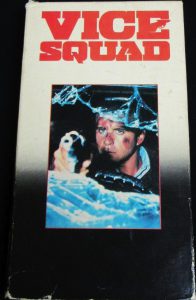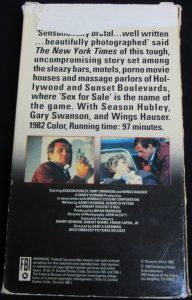#FridayNightAtTheHomeDriveIn
Vice Squad (1982) by #GaryShermanw/ #SeasonHubley #GarySwanson #WingsHauser #PepeSerna #BeverlyTodd
"She's a whore… he's a psychotic pimp bent on REVENGE"
"On the street, the real trick is staying alive."#Action #Crime#NotQuiteClassicCinema pic.twitter.com/eeBSpLbMkO
— Angus Kohm (@AngusKohm) May 23, 2020
I remember the VHS/Beta box staring up at me from the the video store shelf. I instantly wanted to rent it, more so than many of the other boxes on the shelf. Why? I’m really not sure. Did I recognize Vice Squad (1982) as a film that might push some of the same buttons (on me) as movies like movies like Death Wish II (1982), Dirty Harry (1971) and 10 to Midnight (1983), which I had already enjoyed? Could I sense that Vice Squad inhabited a similarly sleazy, and violent but visually exciting world? Maybe, but it’s hard to see how.
The movie box (which would have been Beta for me at that time), was relatively simple: The title of the movie overtop of one photograph of a bruised and bloody man (I think I would have presumed him to be a cop) pointing a gun out through the shattered windshield of a car.
He is in fact vice squad cop Tom Walsh, played by Gary Swanson. The back of the box features two tasteful photos of the same cop; in one, he’s holding a gun and pressed up against a wall, in the other, he’s talking to a woman on a stretcher. Nothing terribly lurid or sensational.
Perhaps it was the description on the back of the box that pulled me in, which promised a “tough, uncompromising story set among the sleazy bars, motels, porno movie houses and massage parlors of Hollywood and Sunset Boulevards, where ‘Sex for Sale’ is the name of the game.” Maybe, but I don’t think so. I knew I wanted to rent that movie before I even picked it up and turned it over.
So, what’s left? Intuition? Some sort of psychological phenomenon? Just a random feeling?
I’ll probably never know for sure what made me slap my money on the counter and take Vice Squad home with me all those years ago. But I was sure glad that I did. It became an instant personal favourite, and I wound up watching it several times over the next few years.
Vice Squad was directed by Gary Sherman, who made another favourite of mine from those early days of bringing home movies on Beta: Dead & Buried (1981). I did not make that connection at the time, but it’s interesting to realize it now. The only other movie of Sherman’s that I remember seeing when it first came out was Wanted: Dead or Alive (1986). I enjoyed it (and have a copy in my collection) but probably not as much as the other two. Sherman’s first feature film (and the only one her made prior to Dead & Buried and Vice Squad) was Raw Meat AKA Death Line (1972). It’s a British horror film with a cult following, but I didn’t see it until last year.
As for the cast of Vice Squad, I didn’t recognize any of them when I first saw the movie. Gary Swanson, as the tough cop, was not a star like Clint Eastwood or Charles Bronson. Season Hubley as Princess, the hooker who runs afoul of a psychopathic pimp, was a complete unknown to me. I was a fan of Linda Blair, who I first saw in Summer of Fear (1978), and then later in The Exorcist (1973). The 1980s saw her embracing the sleazy and violent worlds of movies like Chained Heat (1983) and Savage Streets (1984). It wasn’t hard for me to imagine Vice Squad fitting in perfectly with Linda’s new grown up persona, but alas, she wasn’t in it.
Even when re-watching Vice Squad last week, I did not recognize the name Season Hubley, although it turns out that she has quite a respectable list of credits. I have undoubtedly seen her in a few things over the years, most notably Escape from New York (1981) and Hardcore (1979), but I only remember her, very strongly, from this one performance in Vice Squad.
Wings Hauser is, of course, the breakout star of Vice Squad. I did not know him at all when I first saw the movie, but he is so over the top brilliant as the crazy, violent pimp Ramrod, that his future status was undeniable. I can’t count the number of movies that I have enjoyed him in, from high quality serious films like A Soldier’s Story (1984), to the lowest quality of z-grade trash like Geteven AKA Road to Revenge (1993) – which everyone needs to see, by the way (but that’s another story). As far as I am concerned, Vice Squad is the start of Wings Hauser’s brilliant career. And anyone who has ever enjoyed him in anything should take a look at this film.
It’s always an exciting #FridayNightAtTheHomeDriveIn when I am reunited with a #NotQuiteClassicCinema favourite of my younger days. I can’t explain why I haven’t watched Vice Squad (1982) in over 25 years, any more than I explain what made me rent it in the first place back in the 1980s. But none of that really matters anyway. The important thing is that it is now in my personal library, and I will not let another 25 years go by before I enjoy it all over again. And again. And again…



